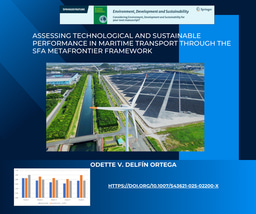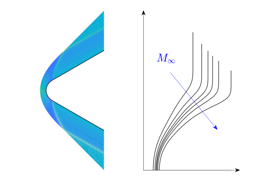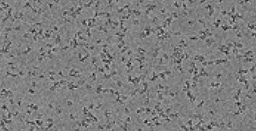
It is not really magic. It is chemistry, which could take place in a cloud droplet, a wet aerosol, or on the surface of a dust particle.
Natural events like dust storms, ocean wave action, volcanic eruptions, wildfires increase the amounts of aerosols in the atmosphere. Trees in forests emit gases, which react in the atmosphere to form particles as well. Human activities, rapid urbanization and industrialization that involve burning of fossil fuels also increase the number of aerosols in addition to the gases that react in the atmosphere to form particles.
Aerosol properties influence climate. The effect of aerosols on climate may rival the warming of CO2 but depends on the variation of chemical composition. In general, aerosols can scatter or absorb incoming solar light. That is why they affect visibility on hazy days. These optical properties are influenced by the chemical composition. Light-absorbing organic aerosols are known as brown carbon to distinguish them from black carbon composed mostly of graphene layers. Measuring aerosols’ size and ‘color’ and how they change with time helps scientists in assessing their climate effect. These properties change because aerosols provide surfaces for water uptake and chemical reactions. Also, aerosols influence cloud formation and lifetime, and depending how high clouds are, they could cause heating or cooling. Furthermore, precipitation and wet deposition also affects the lifetime of these complex aerosols in the atmosphere.
Active areas of research in atmospheric chemistry include aerosol aging and pathways that lead to new particle formation, particle growth, and removal. Aerosol aging refers to processes that change the chemical and physical properties of aerosols during their residence time in the atmosphere. Some volatile organic compounds produce colored secondary organic aerosols from gas phase, liquid phase and multiphase oxidation reactions. Growth of particulate matter takes place due to condensation of semi- to low volatility chemicals and atmospheric heterogeneous chemistry that increases water uptake.
Because of their diverse sources, atmospheric aerosols are chemically complex. They contain salts, organics, and transition metals. The latter originates from mineral dust and iron is the most ubiquitous transition metal in these particles. Plumes of mineral dust mix with pollution from biomass burning smoke during long range transport. Some of the organic carbon in biomass burning smoke is prone to oxidation and complexation with iron. However, the efficiency and nature of products from these reactions taking place under simulated aerosol and cloud conditions remain open research questions.
In a recent publication in Communications Chemistry, an international collaboration led by Hind Al-Abadleh from Wilfrid Laurier University, Marcelo Guzman from the University of Kentucky, and Akua Asa-Awuku from the University of Maryland focused on studying largely unexplored reactions of iron with aminophenols. The research funded by the Natural Science and Engineering Council of Canada and the U.S.A. National Science Foundation carefully examined the role of aminophenols in forming colored nitrogen-containing organic carbon. Aminophenols are examples of nitrogen-containing organic carbon, an important class of brown carbon whose contribution to climate forcing and aerosol-cloud interactions remains a large source of uncertainty in climate models due their chemical complexity and variable sources. These aromatic amines have been detected in the gas phase and ultrafine particulate matter from industrial emissions and from the reduction of nitrobenzenes and nitrophenols from biomass burning.
Our results show remarkably efficient formation of dark brown to black soot-like and water-soluble products under atmospherically-relevant conditions. These products are oligomers containing 2-4 benzene rings with nitrogen and hydroxyl substituents from the abiotic iron-catalyzed oxidation of the aminophenols. We explored these reactions in homogeneous (i.e., aqueous phase) and heterogeneous systems (i.e, liquid/solid interface) using Arizona test dust. We found that the hygroscopicity of the reaction products is higher than that of levoglucosan, a prominent proxy for biomass burning organic aerosol. We also reported progressive darkening of Arizona test dust with reaction time with clear changes to optical properties, morphology, mixing state, and chemical composition.
Metal-catalyzed chemistry is a poorly understood branch of atmospheric sciences despite the widespread presence of iron and other transition metals in particulate matter, in cloud and fog droplets, and on natural and engineered surfaces exposed to the air. Our studies highlight overlooked pathways that lead to the transformations of atmospheric aromatic amines in iron-containing dust systems. These transformations affect cloud condensation nucleation efficiencies of multicomponent aerosol particles and change the physicochemical properties of the aerosols. These potentially important pathways are currently unaccounted for in climate and atmospheric chemistry models, and hence our results will help fill the gap in our understanding of the of the chemistry of iron in aerosols with various degrees of atmospheric processing.
Further readings:
Al-Abadleh, H. A., Kubicki, J. D. & Meskhidze, N. A perspective on iron (Fe) in the atmosphere: air quality, climate, and the ocean. Environ. Sci.: Processes Impacts (Advance Article) https://doi.org/10.1039/D2EM00176D (2022).
Al-Abadleh, H. A. & Nizkorodov, S. A. Open Questions on Transition Metals Driving Secondary Thermal Processes in Atmospheric Aerosols. Comm. Chem. 4, 1-4, https://doi.org/10.1038/s42004-021-00616-w (2021).
Rana, M. S. & Guzman, M. I. Surface Oxidation of Phenolic Aldehydes: Fragmentation, Functionalization, and Coupling Reactions. J. Phys. Chem. A (ASAP Article) https://doi.org/10.1021/acs.jpca.2c04963 (2022).
Malek, K. A., Rastogi, D., Al-Abadleh, H. A. & Asa-Awuku, A. Hygroscopicity of Nitrogen Containing Organic Carbon Compounds: o-aminophenol and p-aminophenol. Environ. Sci.: Processes Impacts (Advance Article), https://doi.org/10.1039/D2EM00163B (2022).
Follow the Topic
-
Communications Chemistry

An open access journal from Nature Portfolio publishing high-quality research, reviews and commentary in all areas of the chemical sciences.
Related Collections
With Collections, you can get published faster and increase your visibility.
Advances in Polymer Synthesis
Publishing Model: Open Access
Deadline: Jan 31, 2026
f-block chemistry
Publishing Model: Open Access
Deadline: Feb 28, 2026






Please sign in or register for FREE
If you are a registered user on Research Communities by Springer Nature, please sign in
DOI: 10.1038/s42004-022-00732-1